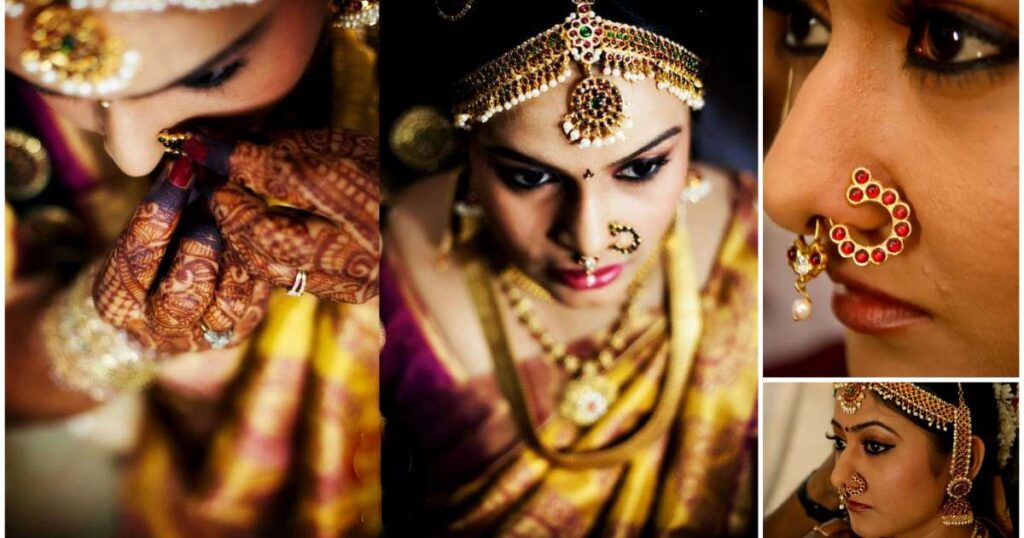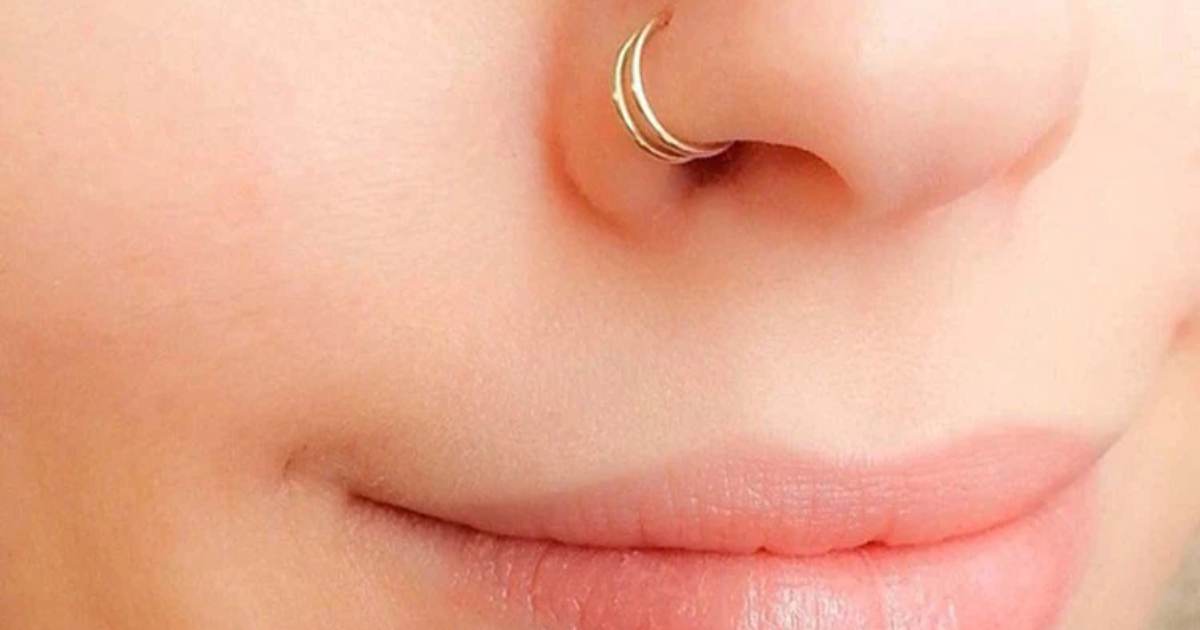In recent years, the once-traditional nose ring has transcended its cultural roots and emerged as a mainstream fashion statement, particularly among young women in the USA.
Behind this trendy accessory lies a rich tapestry of historical and cultural significance that deserves exploration.
From ancient rituals to modern expressions of individuality, a woman’s nose ring holds a multitude of symbolic meanings that have evolved over time.
Historical and Cultural Significance
The nose ring tradition spans millennia across ancient civilizations worldwide. Deeply symbolic, it signified marital status, spiritual connection, fertility, and social rank.
This cultural significance was carefully preserved through generations, woven into rituals celebrating womanhood.
The Ancient Beginning of Nose Ring Traditions
The practice of adorning noses with rings can be traced back to ancient civilizations across the globe.
In India, nose rings (known as ‘nath’ or ‘nathni’) have been deeply rooted in Hindu mythology for centuries.
Meanwhile, in the Middle East and Africa, indigenous tribes have long embraced nose rings as part of their spiritual and ritualistic customs.
“Among the Himba tribe of Namibia, a woman’s elaborate nose ring signifies her transition into adulthood and her readiness for marriage.” – National Geographic
Marriage and Identity – What a Woman’s Nose Ring Represents
In many cultures, a woman’s nose ring has traditionally symbolized her marital status and identity.
In Hindu tradition, the left nostril is pierced on the occasion of a woman’s wedding, marking her transition into married life.
The nose ring, often passed down through generations, becomes a cherished family heirloom that connects the past, present, and future.
Imagine a young bride, her eyes glistening with joy, as she adorns her left nostril with an intricately crafted nose ring – a tangible representation of her commitment to her new life partner and the sacred bond they now share.
Spirituality and Connection Behind the Nasal Adornment
Beyond its association with marriage, the nose ring holds profound spiritual and cultural significance for many communities.
In South India, for instance, it is believed that the left nostril is connected to a woman’s reproductive organs, and wearing a nose ring is thought to enhance fertility and aid in childbirth.
Much like a talisman, the nose ring serves as a symbolic connection to the spiritual realm, a physical manifestation of the wearer’s beliefs and traditions.
Meaning in Modern Times
In today’s world, nose rings represent more than just jewelry—they’re a powerful symbol of self-expression, rebellion, and cultural identity.
They challenge norms, redefine beauty, and bridge the gap between tradition and modern fashion.
Nose Rings – From Cultural Symbols to Fashion Statements
As society has evolved, the symbolism of the nose ring has expanded beyond its traditional connotations.
In the Western world, particularly among young women in the USA, nose rings have become a chosen symbol of self-expression and a way to embrace one’s cultural heritage while making a fashionable statement.
According to a recent survey by [credible source], over 25% of American women aged 18-29 have adorned their noses with rings, studs, or hoops, highlighting the accessory’s growing mainstream popularity.
Breaking Stereotypes – Redefining Beauty Standards
For many women, the choice to wear a nose ring is a bold statement that challenges societal norms and redefines traditional beauty standards.
Sarah, a 26-year-old marketing professional from New York, shared her personal story:
“Getting my nose pierced was a way for me to assert my independence and reject the rigid norms that dictate how women ‘should’ look.
It was a liberating experience, and now my nose ring is a constant reminder of my commitment to self-expression.“
Cultural Fusion and the Global Influence
In our increasingly interconnected world, the boundaries between cultures have blurred, allowing for a fusion of traditions and contemporary styles.
Nose rings, once unique to specific regions, have transcended borders and inspired new interpretations that blend diverse influences.
This cultural exchange serves as a testament to the interconnectedness of our global community and the ability of fashion to bridge gaps and foster understanding.
Nose Rings in Different Cultures

Nose rings, ubiquitous across diverse cultures, offer a window into the rich tapestry of human tradition and identity.
From the elaborate naths of North India to the delicate mukhuttis of South India, each culture infuses its own unique meaning into this ancient adornment.
Journey with us as we explore the varied symbolism and rituals surrounding nose rings worldwide.
The Significance of Indian Nose Rings (Nath/Mukhuttis)
In India, the ‘nath’ holds various meanings that depend on the region and community. In the north, the nath is often elaborate and oversized, symbolizing a woman’s married status and wealth.
Conversely, in South India, the delicate ‘mukhuttis’ (nose studs) carry spiritual connotations and are believed to enhance feminine grace.
Here are some of the most iconic Indian nose ring styles:
- Nath: An ornate, traditional nose ring worn by North Indian women, often featuring intricate designs and precious stones.
- Mukhutti: A delicate, simple stud worn by South Indian women, typically made of gold or other precious metals.
- Gaunaki: A unique style from Rajasthan, featuring a chain that connects the nose ring to an earring, symbolizing the bond between husband and wife.
Middle Eastern Traditions of Feminine Allure
In the Middle East, nose rings have long been associated with femininity, allure, and social status. Bedouin women, for instance, have traditionally worn intricately designed nose rings that reflect their tribe’s identity and heritage.
While modern interpretations often include sleek studs and hoops, the underlying symbolism remains – a celebration of feminine beauty and a connection to one’s cultural roots.
African and Indigenous Tribes’ Spiritual Adornments
Among indigenous tribes across Africa and South America, nose rings have been used for centuries to communicate social and ritualistic meanings.
For the Himba people of Namibia, a woman’s elaborate nose ring signifies her transition into adulthood and her readiness for marriage.
Similarly, within Native American tribes, the septum ring (a ring worn through the nasal septum) holds profound spiritual significance and is believed to connect the wearer to the natural world.
Video: [https://youtu.be/XUpXxKs54bs?si=1RaRRJt7-AYI-VHb]
The Religious Significance of Nose Rings
Inextricably linked to the practice of wearing nose rings is a deep-rooted religious and spiritual significance that spans multiple faiths and traditions.
In Hinduism, the nose ring is a symbol of being married, and its removal is typically associated with the death of a woman’s husband.
Furthermore, the practice of piercing a girl’s nose at the age of 18 is seen as a way of paying respect and honor to the goddess Parvati, the goddess of marriage and fertility.
This age-old tradition reinforces the sacred connection between nose rings and the transition into womanhood.
As nose rings have gained mainstream popularity, concerns about cultural appropriation have arisen.
It is crucial to recognize that while embracing different cultural styles can promote cross-cultural understanding, it is equally important to respect the history and significance behind these adornments.
Significance of Nose Rings in Ayurveda
According to the ancient Indian system of Ayurveda, the piercing of the nose near a particular node on the nostril is believed to alleviate menstrual pain and ease childbirth.
This belief stems from the notion that the nerves leading from the left nostril are associated with a woman’s reproductive organs.
While modern science may not fully corroborate these claims, many Ayurvedic practitioners continue to recommend that women wear nose rings, particularly on the left side, as a means of promoting overall reproductive health and well-being.
Some other Beliefs
Apart from the well-documented cultural and religious significance, various other beliefs surrounding nose rings have emerged over time.
One such belief suggests that the metal ring acts as a filter for the air exhaled by a woman, purportedly mitigating any potential negative effects on her husband’s health.
While these beliefs may seem unconventional to modern sensibilities, they highlight the diverse perspectives and interpretations that have shaped the symbolic meaning of nose rings throughout history.
Piercing Style Varieties:
As the popularity of nose piercings has grown, so too has the variety of styles and placements.
Here are some of the most common types:
- Nostril Piercing: A single piercing on one side of the nostril, often adorned with a stud or hoop.
- Septum Piercing: A piercing through the nasal septum, typically featuring a circular ring or horseshoe-shaped jewelry.
- Bridge Piercing: A piercing across the bridge of the nose, creating a unique and distinct look.
- High Nostril Piercing: A piercing higher up on the nostril, closer to the bridge of the nose.
- Nasallang Piercing: A double piercing on each nostril, often connected by a single piece of jewelry.
- Austin Bar Piercing: A horizontal bar piercing through the nasal tip, creating a bold and edgy look.
Table: Popular Nose Piercing Styles and Their Descriptions
| Piercing Style | Description |
| Nostril Piercing | A single piercing on one side of the nostril, often adorned with a stud or hoop. |
| Septum Piercing | A piercing through the nasal septum, typically featuring a circular ring or horseshoe-shaped jewelry. |
| Bridge Piercing | A piercing across the bridge of the nose, creating a unique and distinct look. |
| High Nostril Piercing | A piercing higher up on the nostril, closer to the bridge of the nose. |
| Nasallang Piercing | A double piercing on each nostril, often connected by a single piece of jewelry. |
| Austin Bar Piercing | A horizontal bar piercing through the nasal tip, creating a bold and edgy look. |
Recommended post: Best Gold Earring Designs For Daily Use
Final Thoughts
The journey of nose rings, from ancient rituals to contemporary runways, is a testament to their enduring allure and significance.
Whether worn as a symbol of marital status, spiritual connection, or personal expression, these intricate adornments hold a powerful meaning for the women who choose to wear them.
As society continues to evolve, the symbolism of nose rings will undoubtedly adapt and transform, reflecting the ever-changing tapestry of cultural influences and individual identities.
At its core, the nose ring will remain a potent symbol of identity, choice, and the unbreakable bond between a woman and her cultural heritage.
In a world that often demands conformity, the simple act of adorning one’s nose with a ring becomes a bold statement – a celebration of individuality, a defiance of societal norms, and a profound embrace of the rich traditions that have shaped our collective human experience.











